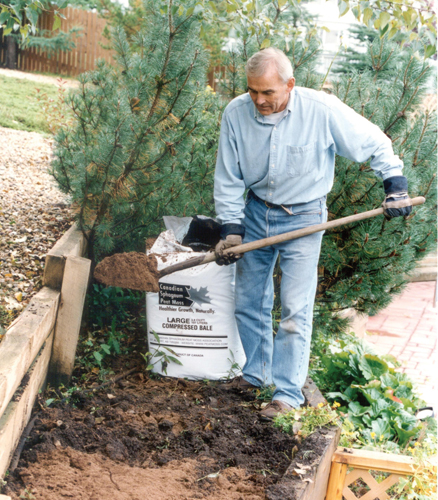Nature May Have Shortchanged Your Soil. Peat Moss Corrects Many Deficiencies

|
A good foundation is the most important ingredient of any endeavor. Whether dancing, writing, building, or gardening, a strong, well-prepared foundation is the key to success. Just try writing a novel without solid language skills, or singing an opera without having mastered your scales.
Creating a garden is much the same. Only in gardening, good soil is the foundation you need before you can create landscape masterpieces.
Most garden plants long for luxurious loamy soil. "Fit" soil -- soil that is full of organic material, of near neutral pH, and with the capacity for good drainage -- produces healthy, better-looking plants. Soil this fit, however, is unusual in the United States; it must be made.
It's not as daunting a task as it sounds. To improve soil, begin by answering some basic questions:
Texture
To determine your soil's texture, scoop some of it up and study it. If it runs through your fingers, then it's too sandy. Water along with nutrients, will drain too quickly to benefit plants.
If it's thick and lumpy and clings together in a ball, then you have heavy soil, most likely with a high clay content. Plant roots will have a hard time penetrating such soil, and they will starve due to lack of air and water.
Adding a large quantity of organic material improves the texture of all soils. Canadian sphagnum peat moss is the easiest choice, and it offers the fastest results. An all-natural, biodegradable, and odor-free organic material, Canadian peat is available in bales at nurseries and garden centers.
If you have compost available, blend it 50:50 with the peat moss; it adds nutrients and helps improve the soil texture.
Dig Into Soil
Spread two to three inches of peat/compost over the soil and dig into the top 6 to 8 inches. This mixture loosens clay soils and improves aeration and drainage. As well, it absorbs moisture and reduces the leaching of fertilizer in sandy soil.
Soil pH
If your soil is well-balanced, fertilizers will work correctly and plants will thrive. You can't judge your soil's chemical composition by just looking at it. You need to know its pH.
A soil's "pH" describes it alkalinity or acidity, as measured on a scale of 1 to 14, with pH 7 representing neutral. Lawns, vegetables, and most flowers prefer a neutral, or slightly acid soil, between 5 and 6.5. Take a 3-inch-deep sample of soil to your garden center and have them test it for pH. They will recommend a remedy if the pH is off.
Important Nutrients
A balance of the three major plant nutrients -- nitrogen (N), phosphorous (P), and potassium of potash (K) -- is necessary for good soil. When you shop for fertilizer, you'll see that the bags are labeled with three-number formulas, such as 5-10-10.
Before planting, spread the fertilizer on top of your soil in the suggested quantity, then dig or till it into the top 3 inches.
Few soils are born perfect. But if you've followed these suggestions, you've created a foundation. Fit soil is now yours and gardening master-works await you.
To order free brochures on "How to ... with peat moss" and other gardening tips, send a self-addressed, unstamped, business-sized envelope to: Peat Moss, Box 385102, Minneapolis, MN, 55438; e-mail cspma@peatmoss.com; or visit www.peatmoss.com.
The Canadian peat industry is committed to making peat moss a sustainable resource. Only one acre in every 6,000 is harvested and when harvesting stops, the bogs are restored to functioning peatlands. For more information on peat and the environment, visit the Canadian Sphagnum Peat Moss Association's Web site at www.peatmoss.com.






